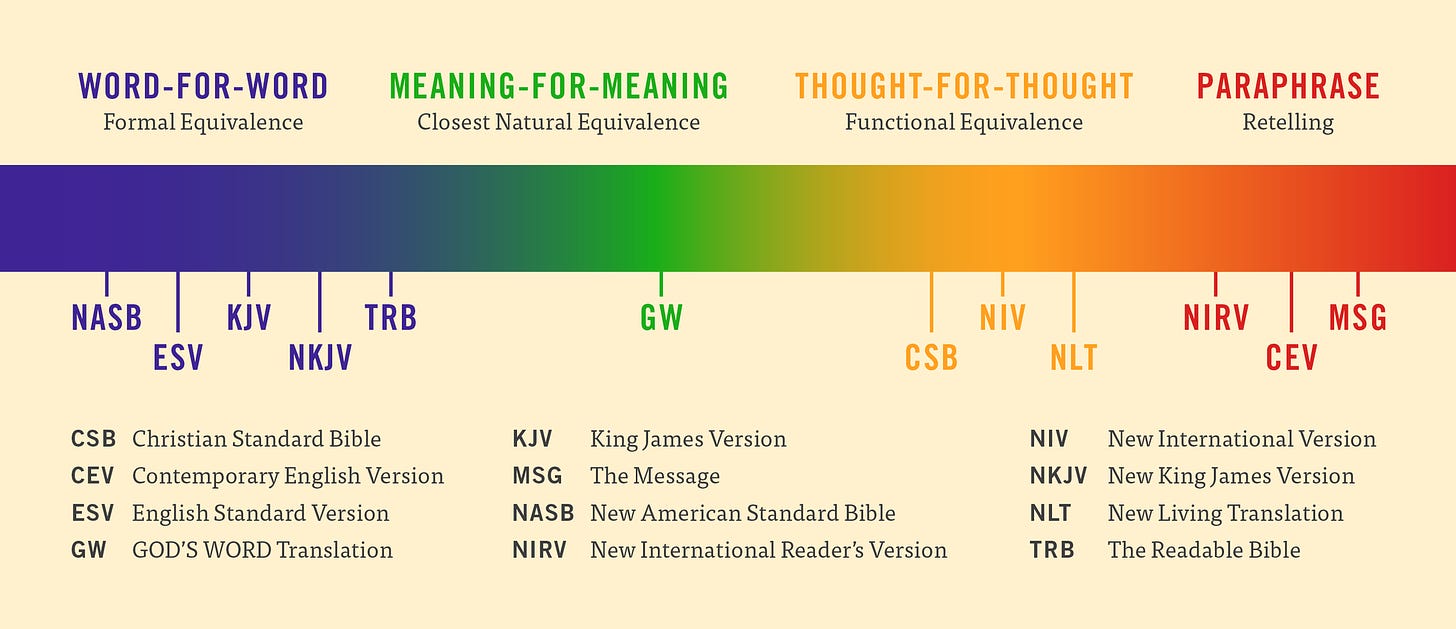
Some people are very passionate about the Bible translation they use. That’s fine - just keep using it. What I’m about to say is not for you.
If you review the Bible translation you use every so often, here are some things to consider.
The Stability of the Translation
Does the translation have “staying power,” or is it a novelty that will disappear in a few years? If possible, it’s beneficial to use a translation that others are using as well.
An excellent way to keep an eye on this is to pay attention to the best-selling list of the Bible over time. The following list came from churchanswers.com:
Rankings as of June 2021 (numbers in parentheses are 2011 rankings).
New International Version (NIV) (1)
King James Version (KJV) (2)
New Living Translation (NLT) (4)
English Standard Version (ESV) (5)
New King James Version (NKJV) (3)
Christian Standard Bible (CSB) (6)
Reina Valera (RV) (not ranked)
New International Reader’s Version (NIrV) (9)
The Message (Message) (8)
Nueva Version International (NVI)(not ranked)
The top six best-selling Bible translations over the last ten years have remained the same. Some have moved up; some have moved down. But the group of six have remained the same - the NIV, KJV, NLT, ESV, NKJV, and CSB.
The popularity of a translation is not the only measurement to use - but it should be something you consider.
The Reliability of the Translation
Some translations are more accurate to the original languages of the Bible (Hebrew, Aramaic, and Greek) than others. Every translation has shortcomings in some areas because the translation was done by a group of uninspired men.
I would strongly suggest that your primary study Bible be a “Word-for-Word” translation. These translations are usually the most accurate to the original languages.
I suggest using the New American Standard Bible (NASB) - although it is not as popular as it used to be - the English Standard Version, the King James Version, or the New King James Version.
“Thought-for-Thought” and “Paraphrase” translations are useful in Bible study, but they are not as reliable as a “Word-for-Word” translation. Don’t rely on something that is less accurate than the original manuscripts.
The Readability of the Translation
When it’s all said and done, you have to be able to read and understand the translation you use. If you struggle with reading the KJV or the NKJV, then switch to a translation that’s easier for you to read and study.
In my personal opinion, the best balance of accuracy and readability in today’s English is the ESV.
I use the New King James Version because it’s a good “stand in the gap” translation between the KJV and the ESV. People who use the KJV can follow along with preaching from the NKJV just fine, and usually, so can people who use the ESV.
Closing Thoughts
We need to be kind to others - even if they use a different translation than us. Someone who uses the ESV is not automatically a liberal heretic just like someone who uses the KJV is not automatically a Pharisee who exalts tradition.
Find a good translation you like, you read, and you use. Stick with until a change needs to be made - if it ever needs to be made.
For Ezra had prepared his heart to seek the Law of the LORD, and to do it, and to teach statutes and ordinances in Israel. (Ezra 7:10)




